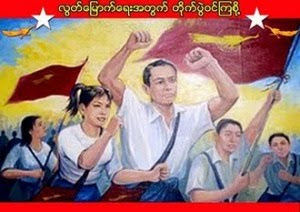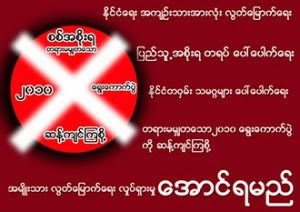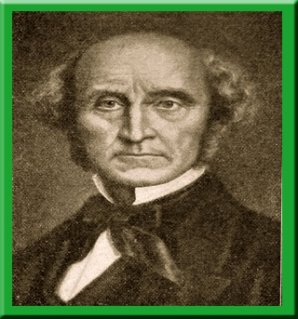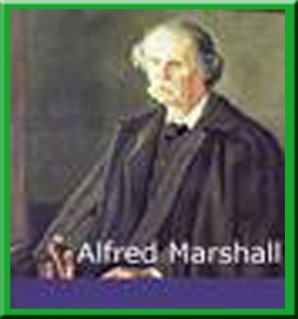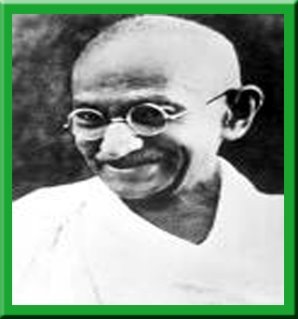Introduction
On 18th of July, 2007, Burmese Military Junta began a final session of the National Convention to draw up the basic principles of a new constitution launched 14 years ago. Despite of human rights abuses and massive political prisoners, the generals are still insisting they are open on the march to democracy. They claimed that the new constitution is carefully designed for a democratic state of Burma. In this article, I would like to mention about the basic principles of constitution structures in consolidated democratic states, the key issues of modern constitutionalism, the importance of civilian control of the military in constitution designs and analyze why Junta’s new constitution is not suitable for a Democratic Burma.
What is a constitution?
A constitution is "[a] charter of government deriving its whole authority from the governed" (Black's Law Dictionary). The Oxford English Dictionary defines a constitution as "a body of fundamental principles or established precedents according to which a state or organization is governed". The Collins dictionary says a constitution consists of "the fundamental principles on which a state is governed, especially when considered as embodying the rights of subjects".
The constitution sets out the form of the government. It specifies the purpose of the government, the power of each department of the government, the state-society relationship, the relationship between various governmental institutions, and the limits of the government. In short, a constitution defines the way that the state is made up and the powers that it holds.
Democratic Constitution Making
According to the classical liberalism, the state and society can be viewed as a big social contract. So in a liberal democratic state, the constitution is a fundamental contract between the state and the civil society.
The state requires not only democratization but also the protection and development of its impartial powers if democracy is to maintain a shape that respects and enforces the rights and obligations of all citizens. In many countries, the limits of the government are defined in constitutions and Bills of Rights which are subjected to public scrutiny, parliamentary preview and judicial process. This idea is fundamental to the principle of autonomy. This can be stated as “Persons should enjoy equal rights and equal obligations in the specification of political framework which generates and limits the opportunities available to them, i.e. they should be free and equal in the determination of the conditions of their own lives” (Held, 1997:301).
Since Locke, the position that viewed that the modern democratic state should provide the necessary conditions to enable the citizens to pursue their own interest has been a central tenet of liberalism. A democracy would be fully worth its name if citizens were able to enjoy a bundle of rights which allowed them to demand democratic participation.
In his report of ‘Democratic Constitution Making’, Vivien Hard mentioned that democratic constitution was no longer simply to establish the democratic governance because it is a constitution that is made in a democratic process and a claim of public participation is the most striking feature of a new constitutionalism. (Hard, 2003:3)
Due to the third wave democratization and the end of the Cold War, new nations and regimes have to seek democratic credentials in making a new constitution. Especially in developing nations, public participation is more important in electing a constitutional convention and ratifying a constitutional text by referendum. Hard mentioned the recent practices in democratic constitution-making process as prior agreement on broad principles as a first phase of constitution making; an interim constitution to create space for longer term democratic deliberation; civic education and media campaigns; the creation and guarantee of channels of communication, right down to local discussion forums; elections for constitution-making assemblies; open drafting committees aspiring to transparency of decision making; and approval by various combinations of representative legislatures, courts, and referendums. (Hard, 2003) In fact, it is clear that norms of democratic procedure, transparency and accountability are now demanding for a democratic constitution that involves wider public participation.
Essentials of liberal democratic constitutionalism
Louis Henkin defines constitutionalism as constituting the following elements:
(1) Government according to the constitution;
(2) Separation of power;
(3) Sovereignty of the people and democratic government;
(4) Constitutional review;
(5) Independent judiciary;
(6) Limited government subject to a bill of individual rights;
(7) Controlling the police;
(8) Civilian control of the military; and
(9) No state power, or very limited and strictly circumscribed state power, to suspend the operation of some parts of, or the entire, constitution.
(Henkin, 2000)
Broadly speaking, these nine elements of democratic constitutionalism can be divided into two groups, which correspond to two basic functions of a liberal constitution: one concerns power construction and power lodging; and the other deals with rights protection. These two groups of institutional arrangements worked together to ensure the supremacy of the constitution, the existence of limited government and the protection of basic freedom.
Examples of Democratic Constitution
(i) Basic Principles of American Constitution
The architectures relied on four basic political principles in creating the Constitution; i.e. republicanism, federalism, separation of powers and checks and balances.
Republicanism is a form of government in which power resides in the people and is exercised by their elected representatives.
Federalism is the division of powers between a central government and state governments. According to the Constitution, the powers vested in the national and state governments are derived from the people who have the ultimate sovereigns.
Separation of powers is the assignment of the lawmaking, law enforcing and law-interpreting functions of governments to respective legislative, executive and judicial branches
Checks and Balances system gives each branch some scrutiny of and control over the other branches. (Goldman, 2005: 74)
(ii) Constitutional structures of Germany
Checks and Balances system gives each branch some scrutiny of and control over the other branches. (Goldman, 2005: 74)
(ii) Constitutional structures of Germany
Five of the most important constitutional structures are set out in Basic Law of the Federal Republic of Germany, i.e., a human-rights based democracy underpinned by the doctrine of the separation of powers and the party state, the republicanism, the rule of law, federalism and the commitment to social policy.
The architects of Germany’s constitutions have chosen a representative democracy rather than the direct democracy; however, direct participation of the people plays an important role in the state and local governments.
According to the principle of republicanism, Germany is a republic with the President as the
head of the state.
The rule of law ensures that legislation shall be subjected to the constitutional order and the executive and judiciary shall be bound by law and justice.
Germany’s federalism emphasizes the goal of equal living conditions in the federal territory and the preservation of legal and economic unity throughout the federation.
The principle of a ‘social government’ stands for social justice and obligates the authorities to provide the basic conditions for a human existence of each of its citizens.
(iii) State Principles of the Philippines Constitution
(iii) State Principles of the Philippines Constitution
The state principles of the Constitution include
· Democratic and republican State: Sovereignty resides in the people and all government authority emanates from them.
· War as an instrument of national policy: It adopts the generally accepted principles of international law as part of the law of the land and adheres to the policy of peace, equality, justice, freedom, cooperation, and amity with all nations.
· Civilian authority is, at all times, supreme over the military. The Armed Forces of the Philippines is the protector of the people and the State.
· The prime duty of the Government is to serve and protect the people.
· The maintenance of peace and order, the protection of life, liberty, and property, and promotion of the general welfare are essential for the enjoyment by all the people of the blessings of democracy.
(To be continued)
Khin Ma Ma Myo (6/8/2007)
· Democratic and republican State: Sovereignty resides in the people and all government authority emanates from them.
· War as an instrument of national policy: It adopts the generally accepted principles of international law as part of the law of the land and adheres to the policy of peace, equality, justice, freedom, cooperation, and amity with all nations.
· Civilian authority is, at all times, supreme over the military. The Armed Forces of the Philippines is the protector of the people and the State.
· The prime duty of the Government is to serve and protect the people.
· The maintenance of peace and order, the protection of life, liberty, and property, and promotion of the general welfare are essential for the enjoyment by all the people of the blessings of democracy.
(To be continued)
Khin Ma Ma Myo (6/8/2007)




















